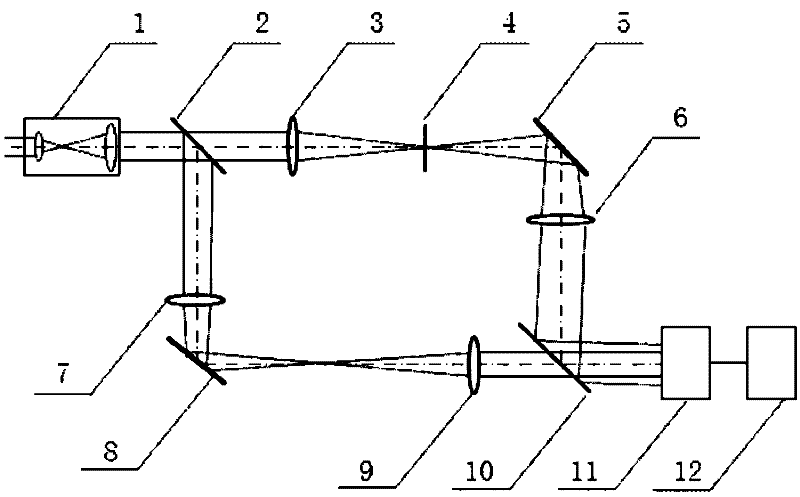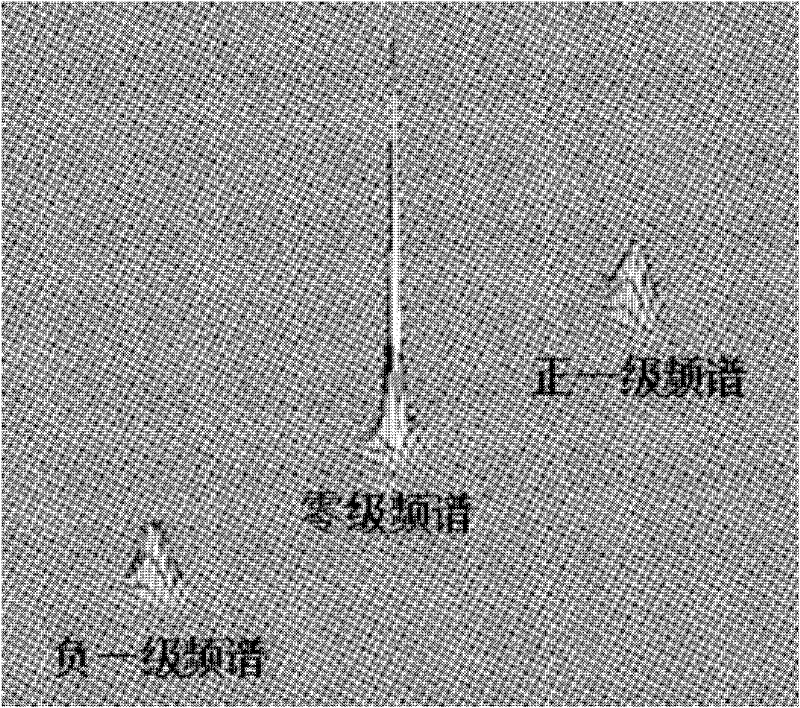Mach-Zehnder point diffraction interferometer and method for reconstructing laser complex amplitudes
An interferometer, complex amplitude technology, applied in the field of optical detection, can solve the problems of limited application and large amount of calculation
- Summary
- Abstract
- Description
- Claims
- Application Information
AI Technical Summary
Problems solved by technology
Method used
Image
Examples
Embodiment 1
[0058] In this embodiment, the structure of the Mach-Zehnder point diffraction interferometer is as follows figure 1 As shown, it includes an optical matching system 1, a first beam splitter 2, a second beam splitter 10, a first reflector 5, a second reflector 8, a first Fourier lens 3, a second Fourier lens 6, the first Three Fourier lenses 7, a fourth Fourier lens 9, a pinhole filter 4, a CCD detector 11 and a computer system 12.
[0059] The optical matching system 1 adopts a telescope system with a magnification of 4 times; the first beamsplitter 2 and the second beamsplitter 10 both use a single-wavelength beam with a transmittance-to-reflectance ratio of 5:5 for a wavelength of 632.8nm. Spectroscopic plate; the first reflector 5 and the second reflector 8 are all high reflectors for the single-wavelength dielectric film of 632.8nm wavelength; the first Fourier lens 3, the second Fourier lens 6, the first Fourier lens The three Fourier lenses 7 and the fourth Fourier len...
Embodiment 2
[0082] In this embodiment, the structure of the Mach-Zehnder point diffraction interferometer is as follows figure 1 As shown, it includes an optical matching system 1, a first beam splitter 2, a second beam splitter 10, a first reflector 5, a second reflector 8, a first Fourier lens 3, a second Fourier lens 6, the first Three Fourier lenses 7, a fourth Fourier lens 9, a pinhole filter 4, a CCD detector 11 and a computer system 12.
[0083] The optical matching system 1 adopts a telescope system with a magnification of 5 times; the first beamsplitter 2 and the second beamsplitter 10 all adopt a broadband beamsplitter flat mirror whose ratio of transmittance and reflectivity for a wavelength of 532nm is 92:8, The first reflection mirror 5 and the second reflection mirror 8 are high-reflection mirrors for the single-wavelength dielectric film of 532nm wavelength; the first Fourier lens 3, the second Fourier lens 6, the third Fourier lens 7 and the first Fourier lens The four Fo...
Embodiment 3
[0086] In this embodiment, the Mach-Zehnder point diffraction interferometer described in Embodiment 1 is used to detect the complex amplitude distribution of the He-Ne laser with a wavelength of 632.8 nm using the first method of the present invention. The steps are as follows:
[0087] (1) Through the optical device of the Mach-Zehnder point diffraction interferometer described in embodiment 1, the laser light to be measured is formed into signal light and reference light, and the signal light and reference light are overlapped and interfered to form spatial carrier frequency interference fringes ;
[0088] (2) by the CCD detector 11 of the Mach-Zehnder point diffraction interferometer described in embodiment 1, the space carrier frequency interference fringes formed by the interference of signal light and reference light are recorded in real time (the collected space carrier frequency interference fringes are as follows: figure 2 shown), and transmit the recorded interfere...
PUM
 Login to View More
Login to View More Abstract
Description
Claims
Application Information
 Login to View More
Login to View More - R&D
- Intellectual Property
- Life Sciences
- Materials
- Tech Scout
- Unparalleled Data Quality
- Higher Quality Content
- 60% Fewer Hallucinations
Browse by: Latest US Patents, China's latest patents, Technical Efficacy Thesaurus, Application Domain, Technology Topic, Popular Technical Reports.
© 2025 PatSnap. All rights reserved.Legal|Privacy policy|Modern Slavery Act Transparency Statement|Sitemap|About US| Contact US: help@patsnap.com



